| ml_experience | class_attendance | lab1 | lab2 | lab3 | lab4 | quiz1 | quiz2 | |
|---|---|---|---|---|---|---|---|---|
| 0 | 1 | 1 | 92 | 93 | 84 | 91 | 92 | 90 |
| 1 | 1 | 0 | 94 | 90 | 80 | 83 | 91 | 84 |
| 2 | 0 | 0 | 78 | 85 | 83 | 80 | 80 | 82 |
| 3 | 0 | 1 | 91 | 94 | 92 | 91 | 89 | 92 |
| 4 | 0 | 1 | 77 | 83 | 90 | 92 | 85 | 90 |
| 5 | 1 | 0 | 70 | 73 | 68 | 74 | 71 | 75 |
| 6 | 1 | 0 | 80 | 88 | 89 | 88 | 91 | 91 |
Introduction to Machine Learning
Which cat do you think is AI-generated?
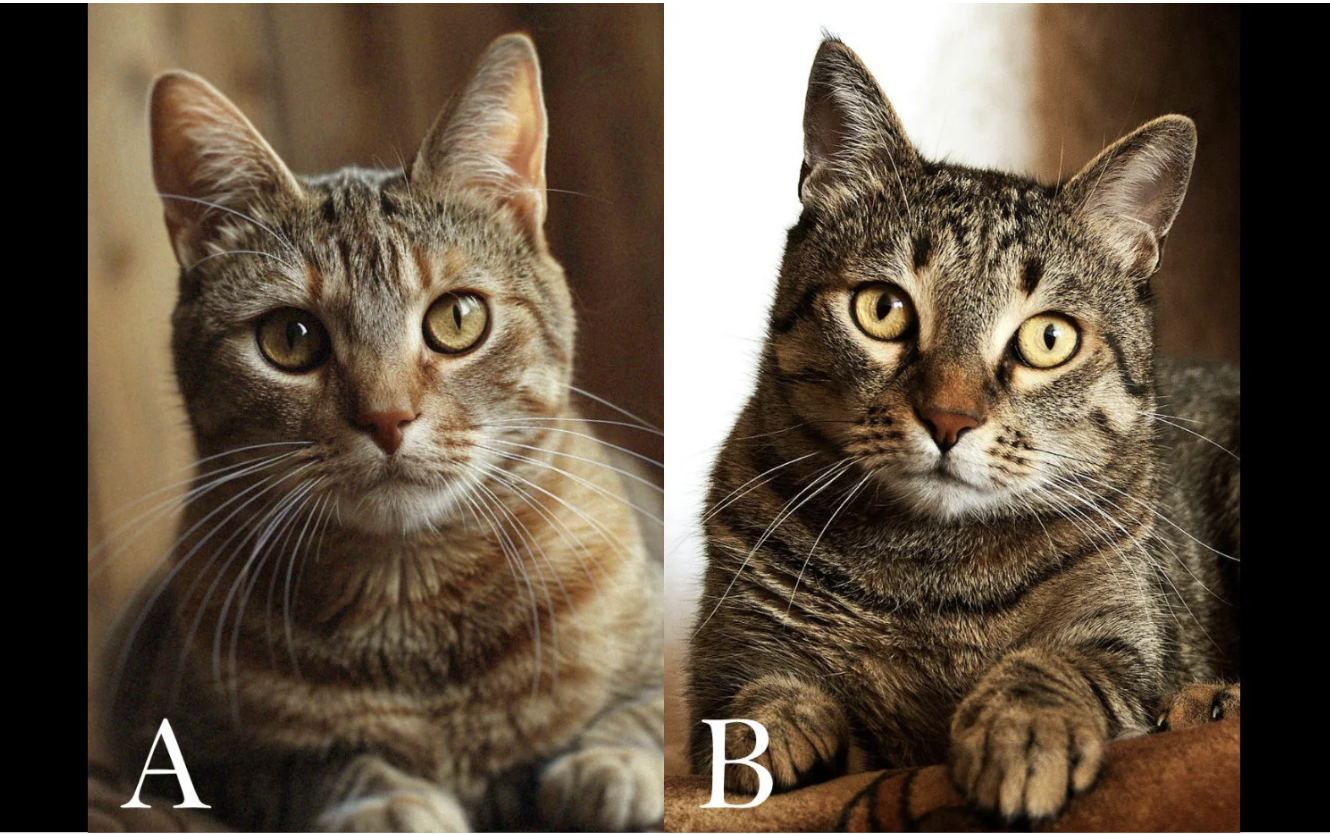 .
.
- A
- B
- Both
- None
- What clues did you use to decide?
AI vs. ML vs. DL
- What is AI, and how does it relate to Machine Learning (ML) and Deep Learning (DL)?
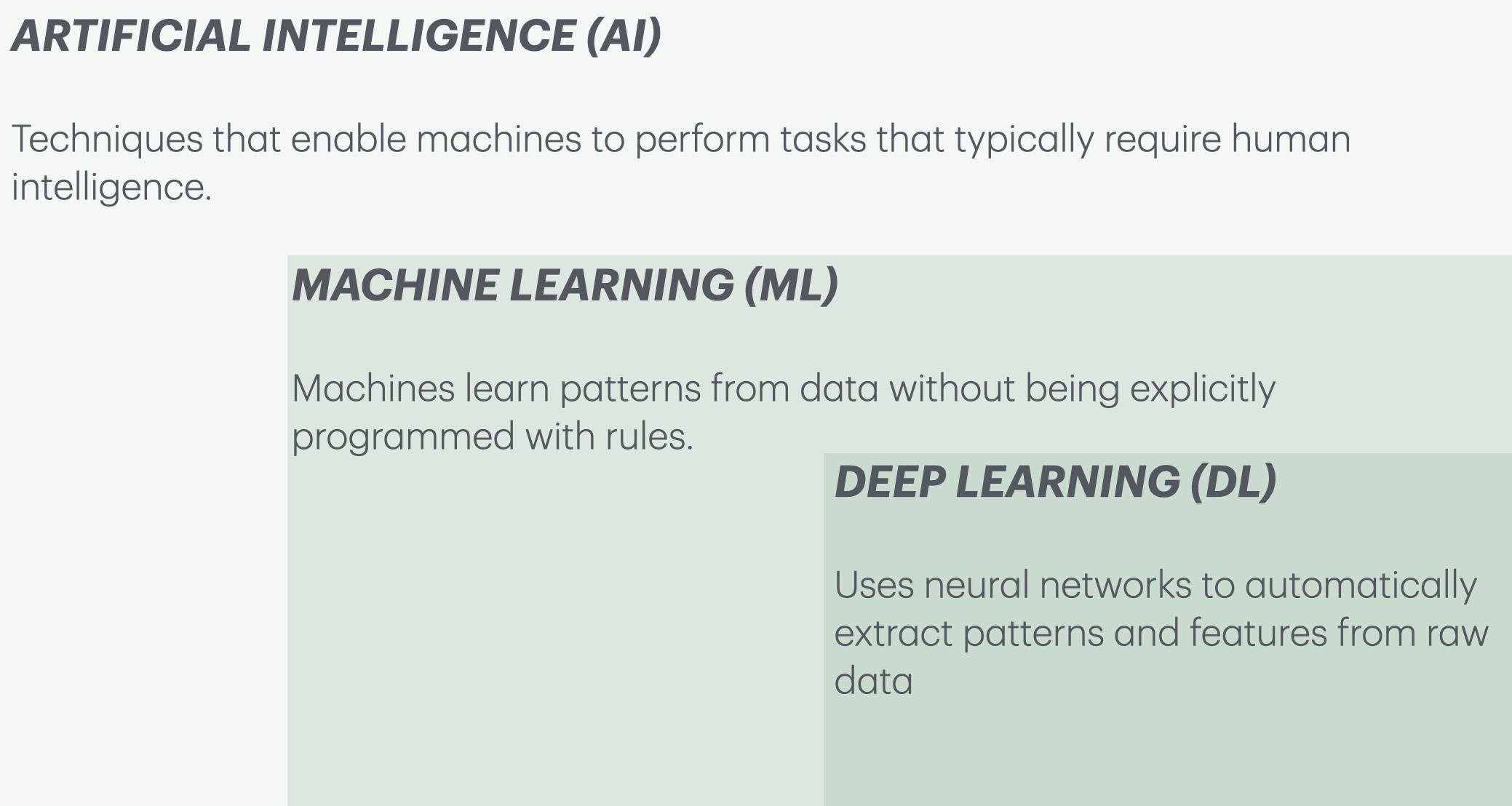 {.nostretch fig-align=“center” width=“700px”}
{.nostretch fig-align=“center” width=“700px”}
Example: Image classification
- Have you used search in Google Photos? You can search for “cat” and it will retrieve photos from your libraries containing cats.
- This can be done using image classification.
Image classification
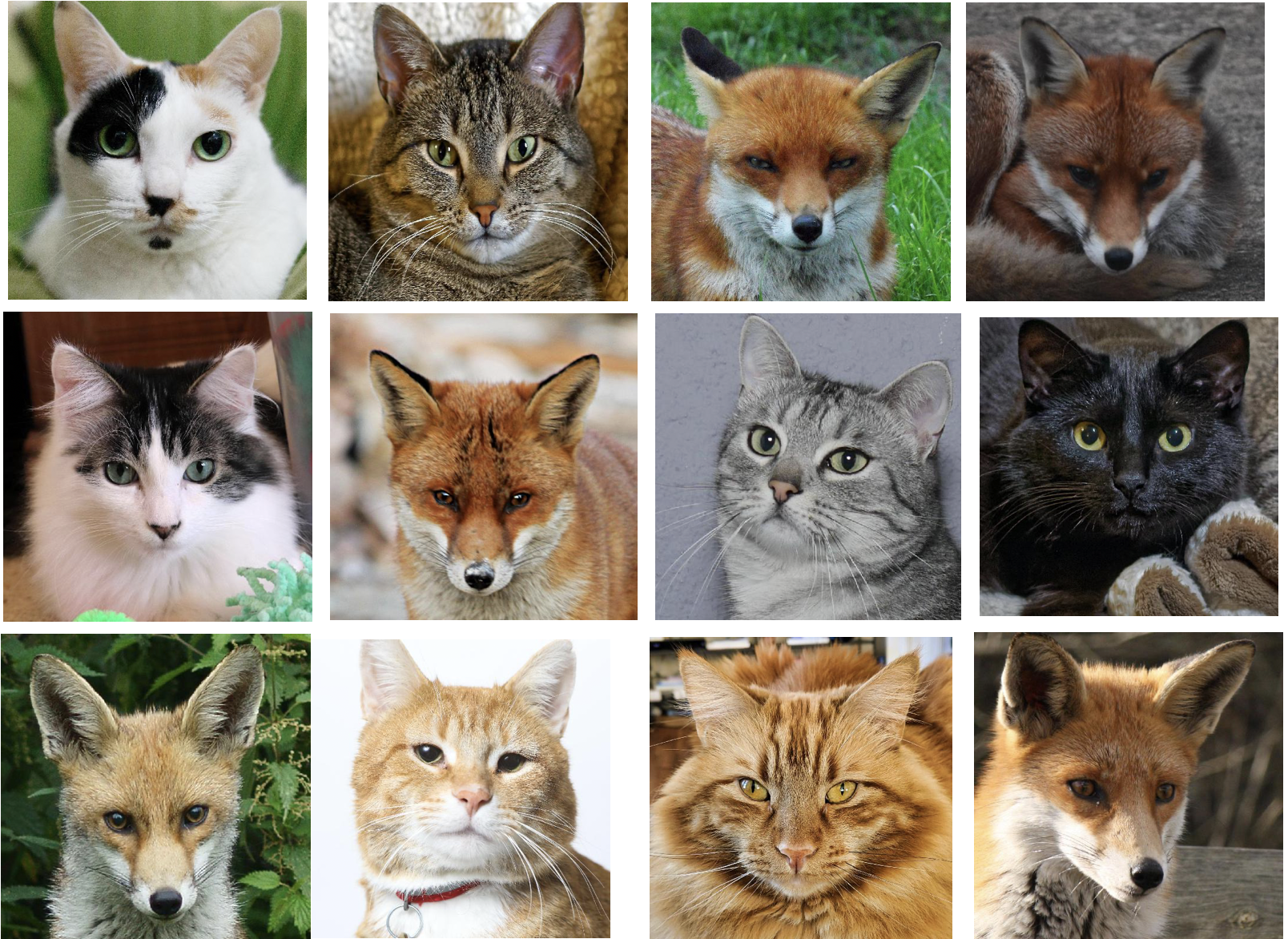
- Imagine you want to teach a robot to tell cats and foxes apart.
- How would you approach it?
AI approach: example

- You hard-code rules: “If the image has fur, whiskers, and pointy ears, it’s a cat.”
- This works for normal cases, but what if the cat is missing an ear? Or if the fox has short fur?
ML approach: example

- We don’t tell the model the exact rule. Instead, we give it labeled examples, and it learns which features matter most.
- small nose ✅
- round face ✅
- whiskers ✅
- Instead of giving rules, we let the model figure out the best combination of features from data.
DL approach: example

- The robot figures out the best features by itself using a neural network.
- Instead of humans selecting features, the neural network extracts them automatically, from edges to textures to full shapes.
- The more data it sees, the better it gets.
When is ML suitable?
- ML excels when the problem involve identifying complex patterns or relationships in large datasets that are difficult for humans to discern manually.
- Rule-based systems are suitable where clear and deterministic rules can be defined. Good for structured decision making.
- Human experts are good with problems which require deep contextual understanding, ethical judgment, creative input, or emotional intelligence.
Supervised learning
- The most common type of machine learning is supervised learning.
- We aim to learn a function \(f\) that maps input features (\(X\)) to target values (\(y\)).
- Once trained, we use \(f(X)\) to make predictions on new, unseen data.
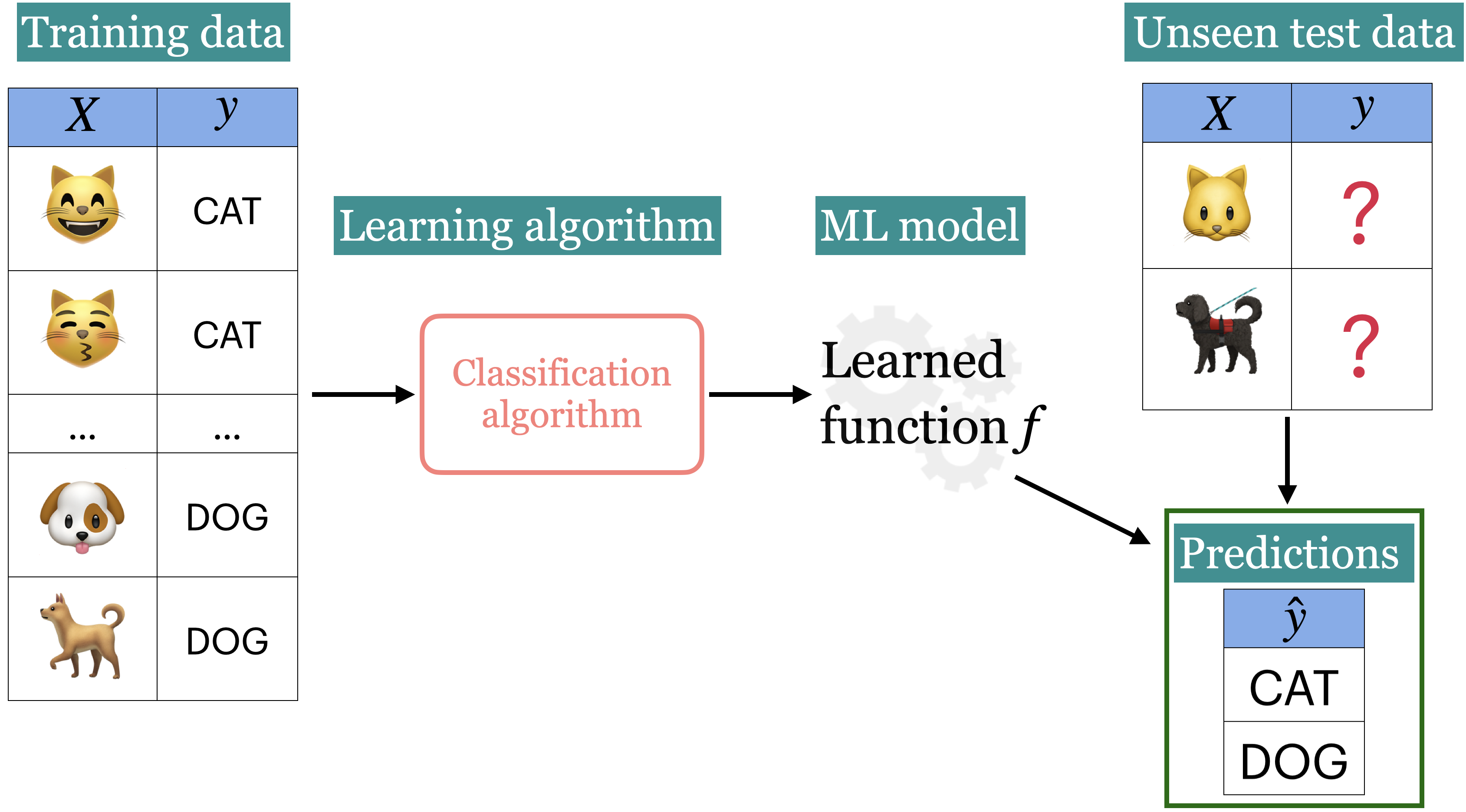
Scenario
Imagine you’re taking a course with four homework assignments and two quizzes. You’re feeling nervous about Quiz 2, so you want to predict your Quiz 2 grade based on your past performance. You collect data your friends who took the course in the past.
Terminology
Here are a few rows from the data.

- Features: relevant characteristics of the problem, usually suggested by experts (typically denoted by \(X\)).
- Target: the variable we want to predict (typically denoted by \(y\)).
- Example: A row of feature values
Running example
- Can you think of other relevant features for this problem?
Classification vs. Regression

Training
- In supervised ML, the goal is to learn a function that maps input features (\(X\)) to a target (\(y\)).
- The relationship between \(X\) and \(y\) is often complex, making it difficult to define mathematically.
- We use algorithms to approximate this complex relationship between \(X\) and \(y\).
- Training is the process of applying an algorithm to learn the best function (or model) that maps \(X\) to \(y\).
Linear models
- Linear models make an assumption that the relationship between
Xandyis linear. - In this case, with only one feature, our model is a straight line.
- What do we need to represent a line?
- Slope (\(w_1\)): Determines the angle of the line.
- Y-intercept (\(w_0\)): Where the line crosses the y-axis. This is also called the bias term
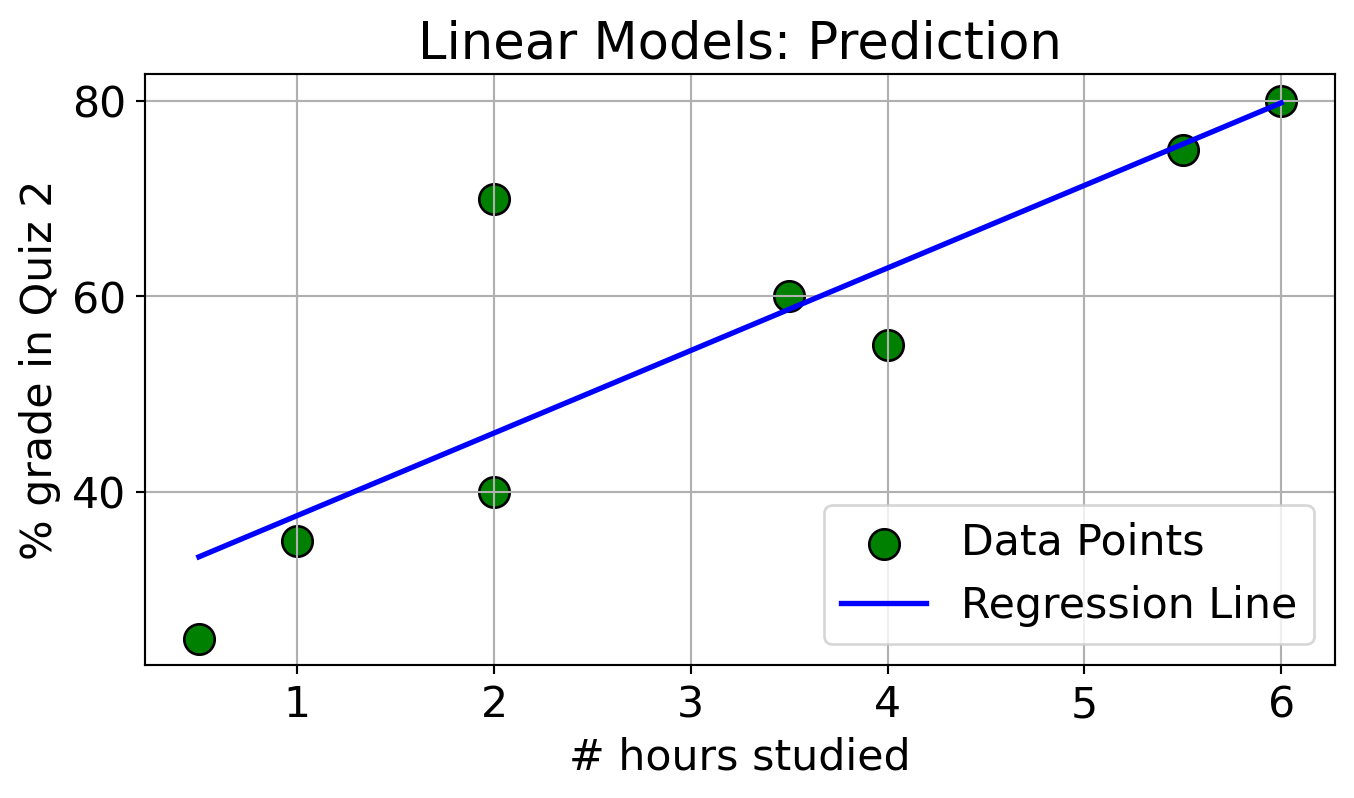
- Making predictions
- \(y_{hat} = w_1 \times \text{\# hours studied} + w_0\)
Logistic regression
- Suppose your target is binary: pass or fail
- Logistic regression is used for such binary classification tasks.
- Logistic regression predicts a probability that the given example belongs to a particular class.
- It uses Sigmoid function to map any real-valued input into a value between 0 and 1, representing the probability of a specific outcome.
- A threshold (usually 0.5) is applied to the predicted probability to decide the final class label.
Logistic regression
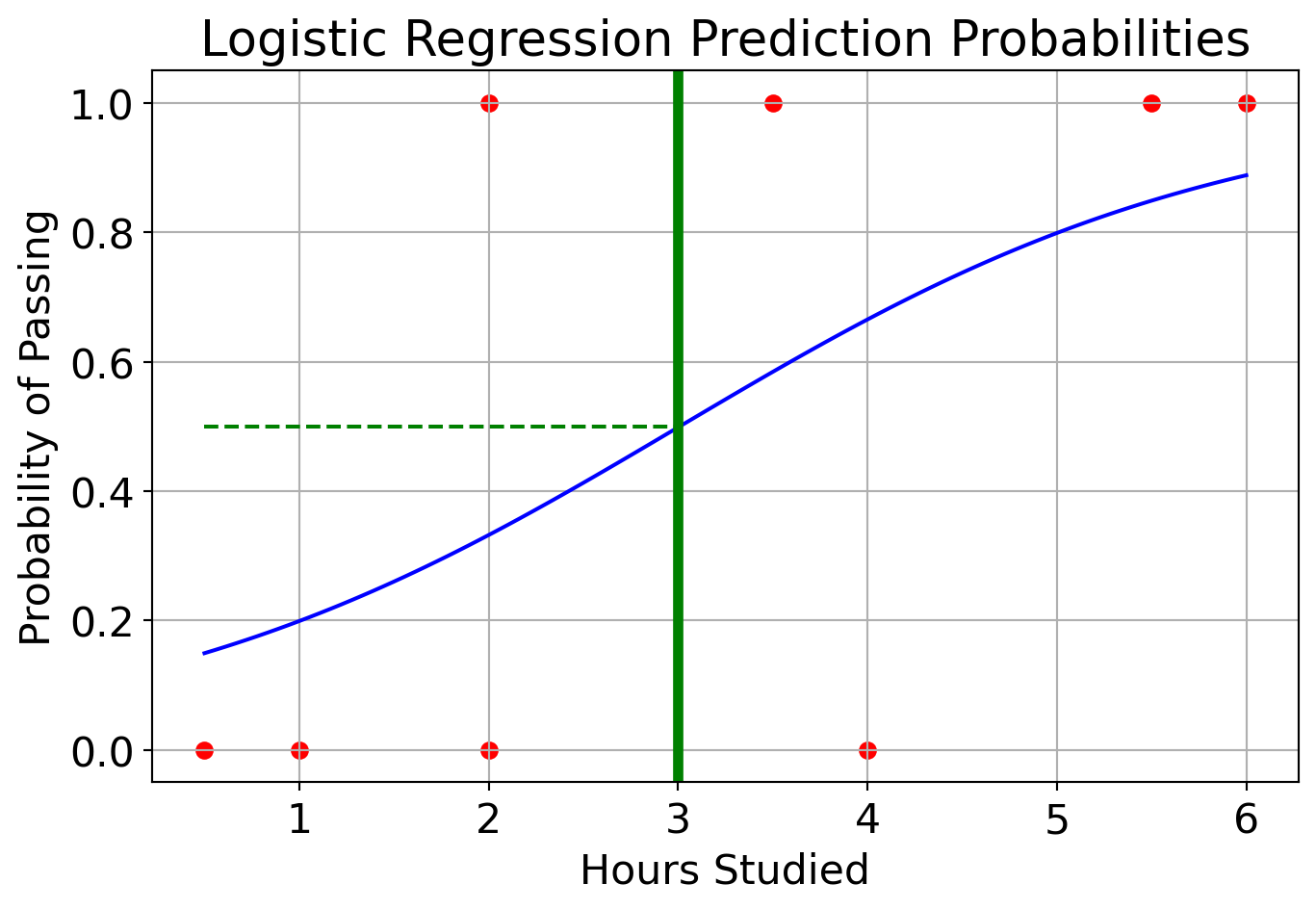
- Calculate the weighted sum \(z = w_1 \times \text{\# hours studied} + w_0\)
- Apply sigmoid function to get a number between 0 and 1.
- \(\hat{y} = \sigma(z) = \frac{1}{1 + e^{-z}}\)
- Model
- If you study \(\leq 3\) hours, you fail.
- If you study \(> 3\) hours, you pass.
A graphical view of a linear model
- We have 4 features: x[0], x[1], x[2], x[3]
- The output is calculated as \(y = x[0]w[0] + x[1]w[1] + x[2]w[2] + x[3]w[3]\)
- For simplicity, we are ignoring the bias term.
Sentiment Analysis: An Example
- Let us attempt to use logistic regression to do sentiment analysis on a database of IMDB reviews. The dataset is available here.
| review | label | review_pp | |
|---|---|---|---|
| 47278 | First of all,there is a detective story:"légi... | positive | First of all,there is a detective story:"légi... |
| 19664 | this attempt at a "thriller" would have no sub... | negative | this attempt at a "thriller" would have no sub... |
| 22648 | What's the matter with you people? John Dahl? ... | positive | What's the matter with you people? John Dahl? ... |
| 33662 | This is another one of those films that I reme... | positive | This is another one of those films that I reme... |
| 31230 | I love Ben Kingsley and Tea Leoni. However, th... | negative | I love Ben Kingsley and Tea Leoni. However, th... |
Bag of Words
- To create features that logistic regression can use, we will represent these reviews with a “bag of words” representation.

Bag of Words
- There are a total of 38867 “words” among the reviews.
- Most reviews contain only a small number of words.
| 00 | 000 | 007 | 0079 | 0080 | 0083 | 00pm | 00s | 01 | 0126 | ... | zurer | zuzz | zwart | zwick | zyada | zzzzip | zzzzz | â½ | â¾ | ã¼ber | |
|---|---|---|---|---|---|---|---|---|---|---|---|---|---|---|---|---|---|---|---|---|---|
| 0 | 0 | 0 | 0 | 0 | 0 | 0 | 0 | 0 | 0 | 0 | ... | 0 | 0 | 0 | 0 | 0 | 0 | 0 | 0 | 0 | 0 |
| 1 | 0 | 0 | 0 | 0 | 0 | 0 | 0 | 0 | 0 | 0 | ... | 0 | 0 | 0 | 0 | 0 | 0 | 0 | 0 | 0 | 0 |
| 2 | 0 | 0 | 0 | 0 | 0 | 0 | 0 | 0 | 0 | 0 | ... | 0 | 0 | 0 | 0 | 0 | 0 | 0 | 0 | 0 | 0 |
| 3 | 0 | 0 | 0 | 0 | 0 | 0 | 0 | 0 | 0 | 0 | ... | 0 | 0 | 0 | 0 | 0 | 0 | 0 | 0 | 0 | 0 |
| 4 | 0 | 0 | 0 | 0 | 0 | 0 | 0 | 0 | 0 | 0 | ... | 0 | 0 | 0 | 0 | 0 | 0 | 0 | 0 | 0 | 0 |
5 rows × 38867 columns
Some words in the vocabulary
array(['00', 'affection', 'apprehensive', 'barbara', 'blore',
'businessman', 'chatterjee', 'commanding', 'cramped', 'defining',
'displaced', 'edie', 'evolving', 'fingertips', 'gaffers',
'gravitas', 'heist', 'iliad', 'investment', 'kidnappee',
'licentious', 'malã', 'mice', 'museum', 'obsessiveness',
'parapsychologist', 'plasters', 'property', 'reclined',
'ridiculous', 'sayid', 'shivers', 'sohail', 'stomaches', 'syrupy',
'tolerance', 'unbidden', 'verneuil', 'wilcox'], dtype=object)Investigating the model
- Let’s see what associations our model learned.
| Coefficient | |
|---|---|
| excellent | 0.637051 |
| great | 0.501922 |
| amazing | 0.499925 |
| perfect | 0.470204 |
| wonderful | 0.450895 |
| ... | ... |
| waste | -0.545904 |
| terrible | -0.569702 |
| boring | -0.595568 |
| awful | -0.687145 |
| worst | -0.922031 |
32230 rows × 1 columns
- They make sense!
Investigating the model
Let’s visualize the 20 most important features.
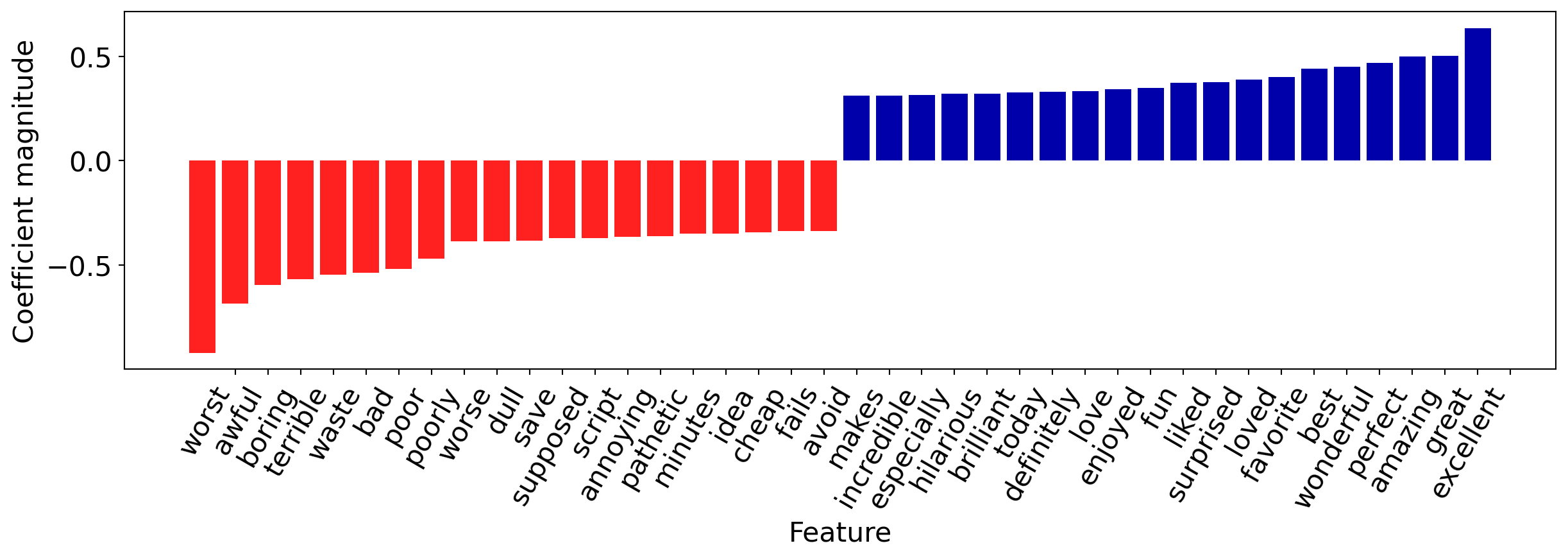
Making predictions
Finally, let’s try predicting on some new examples.
fake_reviews = ["It got a bit boring at times but the direction was excellent and the acting was flawless. Overall I enjoyed the movie and I highly recommend it!",
"The plot was shallower than a kiddie pool in a drought, but hey, at least we now know emojis should stick to texting and avoid the big screen."
]
fake_reviews['It got a bit boring at times but the direction was excellent and the acting was flawless. Overall I enjoyed the movie and I highly recommend it!',
'The plot was shallower than a kiddie pool in a drought, but hey, at least we now know emojis should stick to texting and avoid the big screen.']- Here are the model predictions: